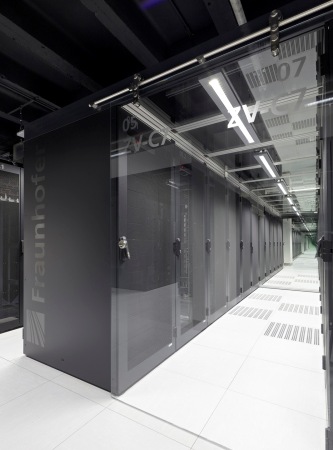Major data centres and supercomputers will soon be more cost and energy efficient, and at the same time will be even more powerful. Fraunhofer scientists and 17 partners from business and research in the European Union have set themselves this ambitious goal in the “PhoxTroT” project. The key is optical data transmission. Over the next four years, the project partners will be studying synergies between existing solutions as well as developing new technologies and strategies.
 Optical data transmission only needs a fraction of the processes that prior systems require. © Fraunhofer IZB
Optical data transmission only needs a fraction of the processes that prior systems require. © Fraunhofer IZB
Gigantic data centres of cloud providers consume energy at an extraordinary rate. For example, Google’s server farms process many petabytes of data and they consume 260 million watts, enough power for a city of 200,000 households. The need to save energy is equally powerful. These facts led the European Union to initiate the PhoxTroT project, coordinated by the Fraunhofer Institute for Reliability and Microintegration IZM in Berlin. The goal is to cut the energy consumption by at least 50 per cent, while simultaneously doubling the capacity of data connections to 2 terabits per second (Tb/s). This would also significantly reduce costs.
Data transmission using light consumes only a fraction of the energy that conventional methods need. The technologies for photonic transmission already exist and have been thoroughly researched. "The novelty of the PhoxTroT project is that we are now researching the synergies between the various technology components and are combining them with each other in a new research plan based on the ‘mix-and-match’ principle," explains project coordinator Dr Tolga Tekin from IZM.
By the end of the project, entirely new technologies are expected to emerge that can guarantee a photonic data connection that remains constant across hundreds of kilometres. For this purpose, the project partners are developing three prototypes for various hierarchy levels. They will realize the optical transmission on a printed circuit board ("on-board"), "board-to-board" and also "rack-to-rack". By combining these interfaces, it will also be possible to bridge longer distances within the foreseeable future. In a further step, the project partners will engineer single-mode solutions that integrate optical chips onto one circuit board. This allows for signal transmission via one optical path, instead of multiple paths as before. Thus, these technologies are particularly well-suited for the transmission of extremely high data rates across long distances.
PhoxTroT: A major project
The European Union is providing EUR 9 million funding for the four-year research project, which began in October 2012. Eighteen companies and scientific installations from all over Europe are involved, and coordinating this project is a major task for IZM, as Tolga Tekin reports: "The greatest challenge is coordinating partners from a wide range of disciplines. On the one hand, for example, there are the technology experts, and on the other hand, systems experts. We have to bring them all to one table, establish an understanding between them and guide the communications into the right channels." This is comparable with dancing, which requires coordination, creativity and stamina, so it is appropriate that the project is called PhoxTroT.